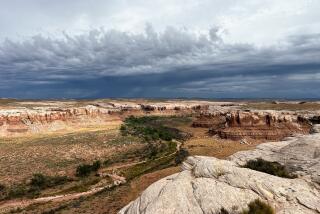1999 Land Deal Fails to Create Safe Haven for Montana Bison
- Share via
BILLINGS, Mont. — For many, a $13-million land deal represented the best hope for creating a safe haven for bison that stray from Yellowstone National Park each winter.
The hope was to provide a place where bison could roam without being hazed, captured or slaughtered out of fear they might infect cattle with a disease called brucellosis. It would be a place where bison and cattle wouldn’t even come into contact.
But six years after the government paid $13 million to a religious sect, the Church Universal and Triumphant, for land and easements north of the park, bison have yet to set hoof there. And they won’t any time soon, federal and church officials say, unless someone is willing to pay the church to stop grazing cattle on its ranch -- a cost that could run several million dollars more.
The Interior Department sought to buy the grazing rights in 1999, seeing them as crucial to ensuring bison would have room to roam outside the park. But that effort was ditched when the appraisal -- nearly $2.8 million, on top of the $13 million -- was much more than government officials were willing to pay.
The stalemate frustrates bison advocates. They contend the government dropped the ball, squandering a golden opportunity not only to protect bison but also to ease tensions between Montana ranchers and animal rights activists.
“I’m so frustrated with this, I could pull my hair out,” said Darrell Geist, checking a member of the Buffalo Field Campaign, an advocacy group dedicated to protecting bison.
Cattle and money have long been sticking points in the debate over how to manage bison in a region where public lands and ranch lands are mingled.
In the 1990s, state and federal agencies were tangled in legal fights and a public relations nightmare over how to deal with bison that were leaving the park to look for winter forage in southern Montana.
The state favored a more aggressive approach than the National Park Service out of concern that bison could spread brucellosis to cattle, said Don Barry, a former Interior Department official. Brucellosis is a disease that can cause cows to abort and, if it turns up in cattle, can lead to trade sanctions against all cattle from that state.
The mass exodus and slaughter of Yellowstone bison during the winter of 1996-97 prompted public outrage and added a sense of urgency to efforts to find a different solution.
The church, meanwhile, was in transition. Headed for years by a charismatic leader, Elizabeth Clare Prophet, it was perhaps best known at one time for building bomb shelters on its property to prepare for an apocalypse that never came. Late in the decade, Prophet had been diagnosed with Alzheimer’s disease, and the church was trying to chart a new course.
It was then that the U.S. Forest Service and the Rocky Mountain Elk Foundation privately asked church leaders if they were interested in selling portions of their Royal Teton Ranch, said Bob Dennee, lands program manager with the Gallatin National Forest. The ranch is the church’s headquarters, and its location -- on Yellowstone’s northern boundary, amid jaw-dropping views -- made it both a playground for wildlife and prime real estate for second homes.
“It was subdivided into ranchettes on paper, if you know what I mean, and development could have gone forward,” said Dennee, a lead negotiator on the land deal.
The elk foundation, which had developed a relationship with the church in earlier land dealings, helped broker the multifaceted deal. The package included the purchase and swapping of lands and a conservation easement for wildlife.
Late in the process, however, Barry realized the plan went a long way toward preserving open spaces but did next to nothing to assure the protection of bison that leave the park. He saw securing the church’s grazing rights as key to allowing bison freer range, and the Interior Department pursued them.
“We would not have gotten in this game if we didn’t feel it would have fixed part of this problem for the bison,” said Barry, now executive vice president of the Wilderness Society.
Kate Gordon, now the church’s president, said the church had always been willing to negotiate a deal for its grazing rights but had had no offers since talks with the government had fallen through years ago.
Terms of the conservation easement now in place allow the church to continue grazing, and Gordon said that would continue unless a deal was reached to compensate the church for the loss of grazing rights.
Also pending is completion of a bison management plan for at least the 1,500-acre conservation easement and, ideally, Dennee said, thousands of surrounding acres. That plan also is necessary before the state would let bison cross Yellowstone’s northern border more freely. But as with the grazing issue, no formal discussions have begun.
Gordon believes the church has lived up to its obligation, “and we stand ready to cooperate with the agencies to find a livable solution for all of us.”
Some critics wonder how long a solution will take and believe political pressure will be needed to move the bison issue forward.
More to Read
Sign up for Essential California
The most important California stories and recommendations in your inbox every morning.
You may occasionally receive promotional content from the Los Angeles Times.










